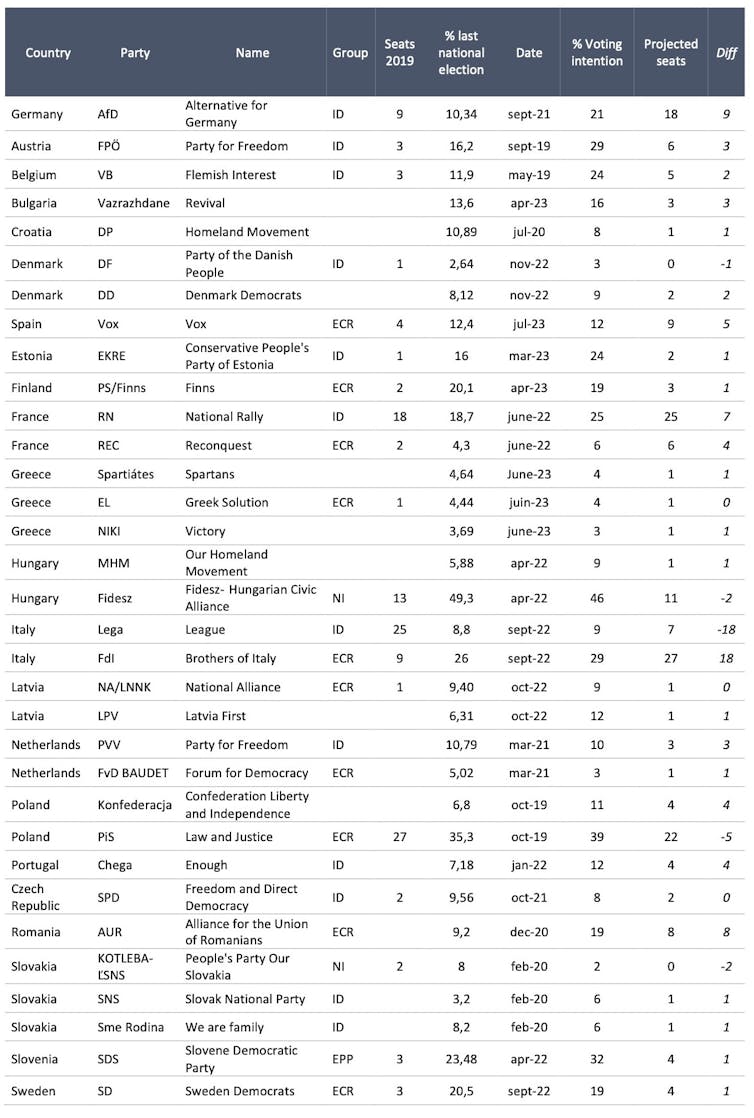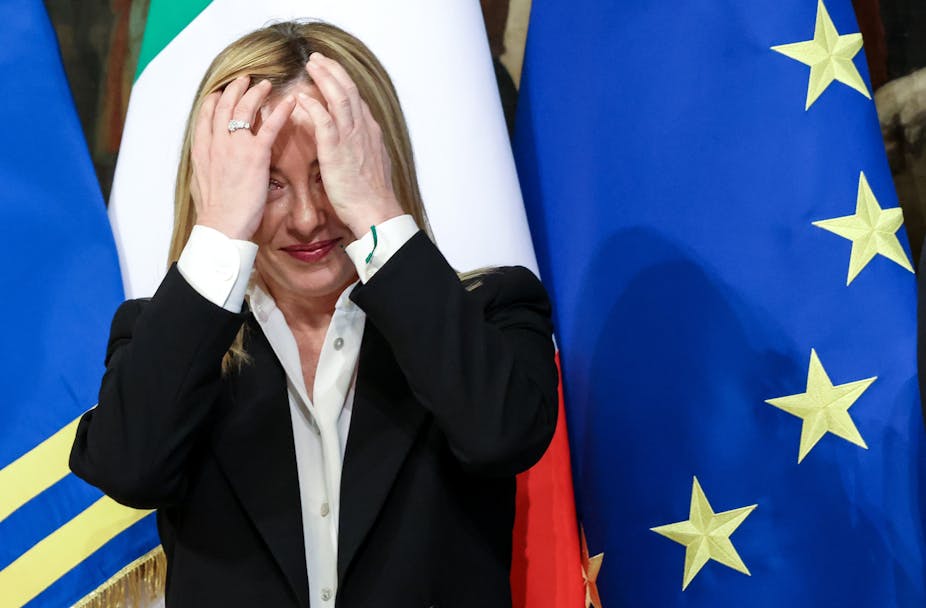A little over a year since leader of Fratelli d'Italia Georgia Meloni rose to power in Italy, the latest data spells out a clear message: she is not the only ultraright politician surfing on voters’ anxieties. In fact, we may be entering a new cycle of far-right extremism across the continent, with heavy stakes for the next European elections in June 2024.
A far right moment
Recent results are eloquent. Last year, in France, Marine Le Pen won an all-time record-high 41.5% of the vote in the second round of the presidential election. In Hungary, Fidesz took 54% of the vote in the parliamentary elections, landing Viktor Orbán a fourth consecutive term. In Sweden, Jimmie Åkesson’s anti-immigrant Sweden Democrats came second with 20.5% of the vote, emerging as new allies for Kristersson’s Moderates.
Elsewhere in Europe, far-right parties are setting roots in countries like Portugal, Spain and Finland, winning substantial support and entering government at local or national level.
They currently top the polls in Austria and Belgium.
In Eastern and central Europe, the far right is on the rise in Estonia, Croatia, Romania and Bulgaria. Notwithstanding opposition parties’ historical, one-million-strong demonstration in Warsaw, the radicalized conservatives of the PiS are still on track to win the next legislative elections in Poland, with 38% of voting intentions, flanked by the Confederation, a heterogeneous extremist group which could win up to 11% of the vote. In Slovakia, the ultra-nationalists of the Slovak National Party (SNS) have entered the country’s national council, and they may form a coalition with Robert Fico’s populist and pro-Russian SMER party.
Multiple layers of resentment
Instead of weakening the far right, the war in Ukraine has created new political opportunities for these parties. Their nationalist and anti-establishment rhetoric resonates with growing political discontent among citizens, along with popular demand for authoritative and strong leadership.
According to the region, ultraright politicians have taken a variety of stances toward Russia. Parties such as Marine Le Pen’s Rassemblement National (RN) in France, Chega in Portugal, and the Dutch PVV have shifted their positions on Putin’s regime, rapidly condemning Russia’s invasion.
Nowadays the far right is riding the economic anxieties of working and middle-class voters affected the most by the economic fallout of the war. Many of these parties, like the French RN, the Italian Lega, the Flemish Vlaams Belang, Chega in Portugal and the Czech SPD, have criticized the sanctions imposed on Russia as primarily hurting their country’s ‘people’, while calling for more social protection and welfare.
Of course, the post-Covid-19 pandemic period is particularly ripe for populist gains: many of these parties, such as Austria’s FPÖ, the Polish Confederation, and the AfD in Germany, fiercely opposed health measures, and have been silently capitalizing on public discontent during the health crisis.
Finally, the surge in support for the far right bears witness to the persistence of cultural and identity-based concerns related to immigration, Islam and multiculturalism. Such issues continue to deeply divide European electorates, as illustrated by current immigration debates in France, Germany, Italy, Austria and the UK. Meanwhile, the Italian island of Lampedusa is once again making the headlines, fuelling fears of new waves of immigration.
The European elections of June 2024 are likely to see the far right entrench itself more deeply into the political landscape. National voting intention polls suggest that far right parties could clinch up to 180 seats in the European Parliament, compared with just about 130 in the current legislature (see Table).
Voting intentions and seat projections for far-right parties in Europe

The Fratelli d'Italia, RN in France, Germany’s AfD and Spain’s Vox should emerge as the big winners, with 27, 25, 18 and 9 seats, respectively. Marine Le Pen has already begun a diplomatic blitz to rally her European far-right allies, and recently launched an offensive against Giorgia Meloni, her main rival for far-right leadership in Europe.
Two former heavyweights, Poland’s PiS and Matteo Salvini’s Lega in Italy, are on the other hand likely to suffer losses in the June 2024 ballot, with an anticipated 22 (-5) and 7 (-18) seats, respectively. In Hungary, Viktor Orbán is set to secure about his 2019 level of support, but is still isolated within the European far right.
Finally, new far-right parties are set to enter the European Parliament: the Alliance for the Union of Romanians (AUR), Chega in Portugal, the Slovak National Party, the Danish Democrats, possibly also Éric Zemmour’s Reconquête in France.
Cutting cordon sanitaires
While essentially reflecting national political dynamics, the current wave of the far right reveals similar trends across Europe, most evidently the mainstreaming of such parties.
In many countries, far-right parties have achieved a strategic equilibrium between government credibility and radical politics. They have toned down their extremism to broaden their electoral appeal and rise to power, most notably by softening their Euroscepticism and by distancing themselves from Putin’s Russia. Meanwhile, these parties have maintained their typical nationalist and authoritarian ideology, combined with anti-establishment populism, which allows them to continue to thrive on voter resentment and anger.
Such a move toward the centre ground of European politics has facilitated political cooperation with parties of the mainstream right in countries like Italy, Finland, Sweden, and Spain. Soon Austria may be added to the list, and possibly Belgium where the growing popularity of the Vlaams Belang is putting the country’s cordon sanitaire under greater strain. Even the German CDU seems now inclined to venture down the dangerous path of forming local alliances with the AfD..
Far-right ideas are infusing the mainstream right as illustrated by the radicalization of parties such as the ÖVP in Austria, the VVD in the Netherlands, and what is left of the Republicans (LR) in France after their 2022 presidential debacle. Such contagion has been most visible in the co-optation of far right’s restrictive immigration policies in those countries.
This complex interplay of forces is key to understanding upcoming reconfigurations at the European level.
How European parliamentary blocs could evolve
The current layout of far-right European parliamentary groups shows a persistent divide between the more “mainstream” Atlanticist parties affiliated with Giorgia Meloni, the Spanish Vox, and Polish PiS within the European Conservatives and Reformists (ECR), on the one hand, and the Identity and Democracy (ID) group, on the other hand. Since its formation in 2019, the ID group has become the main hub for previously pro-Russian far-right and extremist parties around Marine Le Pen, Matteo Salvini, the Austrian FPÖ, and the AfD. Other far right, pro-Russian parties such as Orban’s Fidesz remain with the Non-Inscrits (unaffiliated).
Bolstered by her success in Italy, Giorgia Meloni is seeking a rapprochement with the European People’s Party (EPP), which would pull the ECR toward the centre of European politics. Parties like Vox, the Finns, the Latvian National Alliance, and the Romanian AUR are expected to join, which would bring the ECR group to about 80 seats.
Meloni’s strategic downplay of European and immigration issues certainly opens the door to a broader alliance of the European right. This, however, remains conditional to EPP demands. The chair of the European parliamentary group, Manfred Weber, has clearly indicated that future EPP allies should respect the rule of law and unequivocally support Ukraine, singling out the Polish PiS for its illiberal drift. Additionally, the internal dynamics of the EPP, particularly current disagreements between the CDU (Germany’s Christian Democratic Union) and the CSU (Christian Social Union in Bavaria), may change the course of the group’s trajectory in the next months.
Further to the right, Marine Le Pen and Matteo Salvini will need to rely on their traditional allies in Austria and Belgium, while seeking new partners in Slovakia and Portugal, even perhaps initiating talks with Viktor Orbán. The current configuration and reputation of the ID makes it difficult for Le Pen in particular to distance herself from far-right extremism, which will be essential to her bid to win the next French presidency. Among other challenges, the ID will confront accommodating extremist parties, including a now more powerful yet politically cumbersome AfD that has become nothing less but a refuge for neo-Nazis in Germany.
While many things may change before June 2024, as illustrated by Vox’s setback in the last Spanish elections, the current tide of the far right possibly indicates a shift of Europe’s political centre of gravity. Despite their ‘normalization’, far-right parties remain the primary source of opposition to the foundational values and principles of the European Union, most evidently within the ID group which is likely to continue with its project of a ‘Europe of free and independent nations’.


